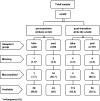Emergency department coding of bicycle and pedestrian injuries during the transition from ICD-9 to ICD-10
- PMID: 21705466
- PMCID: PMC3313444
- DOI: 10.1136/ip.2010.031302
Emergency department coding of bicycle and pedestrian injuries during the transition from ICD-9 to ICD-10
Abstract
Background: The international classification of diseases version 10 (ICD-10) uses alphanumeric expanded codes and external cause of injury codes (E-codes).
Objective: To examine the reliability and validity of emergency department (ED) coders in applying E-codes in ICD-9 and -10.
Methods: Bicycle and pedestrian injuries were identified from the ED information system from one period before and two periods after transition from ICD-9 to -10 coding. Overall, 180 randomly selected bicycle and pedestrian injury charts were reviewed as the reference standard (RS). Original E-codes assigned by ED coders (ICD-9 in 2001 and ICD-10 in 2004 and 2007) were compared with charts (validity) and also to ICD-9 and -10 codes assigned from RS chart review, to each case by an independent (IND) coder (reliability). Sensitivity, specificity, simple, and chance-corrected agreements (κ statistics) were calculated.
Results: Sensitivity of E-coding bicycle injuries by the IND coder in comparison with the RS ranged from 95.1% (95% CI 86.3 to 99.0) to 100% (95% CI 94.0 to 100.0) for both ICD-9 and -10. Sensitivity of ED coders in E-coding bicycle injuries ranged from 90.2% (95% CI 79.8 to 96.3) to 96.7% (95% CI 88.5 to 99.6). The sensitivity estimates for the IND coder ranged from 25.0% (95% CI 14.7 to 37.9) to 45.0% (95% CI 32.1 to 58.4) for pedestrian injuries for both ICD-9 and -10.
Conclusion: Bicycle injuries are coded in a reliable and valid manner; however, pedestrian injuries are often miscoded as falls. These results have important implications for injury surveillance research.
Conflict of interest statement
Figures


Similar articles
-
Limitations of pulmonary embolism ICD-10 codes in emergency department administrative data: let the buyer beware.BMC Med Res Methodol. 2017 Jun 8;17(1):89. doi: 10.1186/s12874-017-0361-1. BMC Med Res Methodol. 2017. PMID: 28595574 Free PMC article.
-
Unspecified falls among youth: predictors of coding specificity in the emergency department.Inj Prev. 2006 Oct;12(5):302-7. doi: 10.1136/ip.2006.011924. Inj Prev. 2006. PMID: 17018670 Free PMC article.
-
A truncated E-code system for injury surveillance in the emergency department: description and clinometric testing.Acad Emerg Med. 1997 Apr;4(4):291-6. doi: 10.1111/j.1553-2712.1997.tb03551.x. Acad Emerg Med. 1997. PMID: 9107328
-
Validity and reliability International Classification of Diseases-10 codes for all forms of injury: A systematic review.PLoS One. 2024 Feb 29;19(2):e0298411. doi: 10.1371/journal.pone.0298411. eCollection 2024. PLoS One. 2024. PMID: 38421992 Free PMC article.
-
Trends in ICD-10-CM-Coded Administrative Datasets for Injury Surveillance and Research.South Med J. 2022 Nov;115(11):801-805. doi: 10.14423/SMJ.0000000000001463. South Med J. 2022. PMID: 36318943 Free PMC article. Review.
Cited by
-
National rates of non-fatal emergency department visits and hospitalisations due to fall-related injuries in older adults 2010-2014 and 2016: transitioning from ICD-9-CM to ICD-10-CM.Inj Prev. 2021 Mar;27(S1):i75-i78. doi: 10.1136/injuryprev-2019-043516. Inj Prev. 2021. PMID: 33674338 Free PMC article.
-
Development and Assessment of a New Framework for Disease Surveillance, Prediction, and Risk Adjustment: The Diagnostic Items Classification System.JAMA Health Forum. 2022 Mar 25;3(3):e220276. doi: 10.1001/jamahealthforum.2022.0276. eCollection 2022 Mar. JAMA Health Forum. 2022. PMID: 35977291 Free PMC article.
-
Validity of Principal Diagnoses in Discharge Summaries and ICD-10 Coding Assessments Based on National Health Data of Thailand.Healthc Inform Res. 2017 Oct;23(4):293-303. doi: 10.4258/hir.2017.23.4.293. Epub 2017 Oct 31. Healthc Inform Res. 2017. PMID: 29181239 Free PMC article.
-
Examination of adult and child bicyclist safety-relevant events using naturalistic bicycling methodology.Accid Anal Prev. 2017 May;102:1-11. doi: 10.1016/j.aap.2017.02.017. Epub 2017 Feb 27. Accid Anal Prev. 2017. PMID: 28245995 Free PMC article.
-
The classic "Carrot-and-stick approach": Addressing underutilization of ICD-10 increased data granularity.N Am Spine Soc J. 2020 Oct 4;4:100032. doi: 10.1016/j.xnsj.2020.100032. eCollection 2020 Dec. N Am Spine Soc J. 2020. PMID: 35141601 Free PMC article. No abstract available.
References
-
- Dennis J, Potter B, Ramsay T, et al. The effects of provincial bicycle helmet legislation on helmet use and bicycle ridership in Canada. Inj Prev 2010;16:219–24 - PubMed
-
- Canadian Institute for Health Information Head Injuries in Canada: A Decade of Change (1994-1995 to 2003-2004). Ottawa, Ontario Canada, 2006. https://secure.cihi.ca/estore/productbrowse.htm?locale=en&Lang=en-US (accessed Sep 2009).
-
- Alexander S, Conner T, Slaughter T. Overview of inpatient coding. Am J Health Syst Pharm 2003;60(21 Suppl 6):S11–14 - PubMed
Publication types
MeSH terms
Grants and funding
LinkOut - more resources
Full Text Sources
Medical
